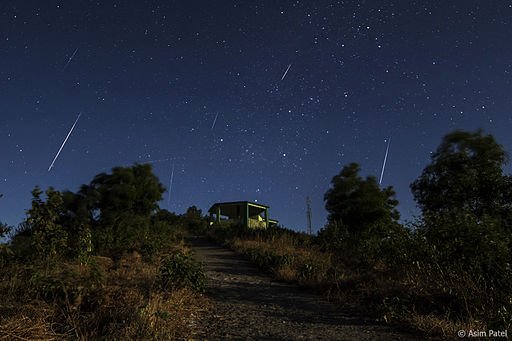Image: Asim Patel, CC BY-SA.3.0, via Wikimedia Commons
2020 might be nearly over, but one of the best stargazing opportunities of the year is yet to come. This weekend, on December 13-14, the Geminids, one of the most beautiful annual meteor showers, will reach its maximum. Provided the sky is clear and sufficiently dark, the spectators might expect to see 60 or more shooting stars every hour.
Here is how, when and where to watch Geminid meteors!
WHEN
The Geminids are known for their beautiful and colourful display. But this year with the Moon out of the way (the shower will peak on the night of the New Moon) the expectations are especially high. We hope you will join thousands of stargazers around the world in observing this celestial wonder!
The Geminid meteors are bright, slow and come in good numbers, meaning that even the first-time stargazers will be able to enjoy the experience. The shower is also a great opportunity for the families with kids to watch shooting stars. The Geminid meteor-hunting can begin as early as 7 pm (although the best display will begin later, around 2 am, when the radiant of the Geminids is high in the sky). Finally, you will need no special equipment or special knowledge to observe the shower.
Here are just a few things to keep in mind
- Find an open space
You will need an unobstructed view of the sky. Trees and buildings are your worst enemies.
- The darker, the better
You can watch the shower from anywhere, even your backyard. But dark locations away from city lights are always the best. You can find a dark sky place here.
- Dress for the weather
You will be sitting still for a long time, so dress up warm, bring a chair (or, even better, recliner) and an extra blanket or a sleeping bag. A flask of hot chocolate will do wonders too!
- Leave the fancy equipment behind. Most of it.
You will not be needing a telescope or binoculars to observe the shower. But if you own a camera with a manual exposure control, why not try and take some photographs of the Geminids! Here is how to photograph a meteor shower.
- Let your eyes adapt!
It will take about half an hour for your dark-adapted vision to ‘switch on”. Be patient! To preserve your dark sensitivity, do not turn on a flash light or your phone screen during a stargazing session. If you absolutely must, use a red light torch. Here is how to make your own red flashlight.
- Plan B
If the weather does not cooperate and the sky is cloudy, try again the following night. The light show will not be as spectacular as on the 14th. But still, you should be able to spot some shooting stars. Alternatively, watch the Geminids from the comfort of your sofa at The Virtual Telescope Project 2.0.
WHERE TO LOOK
The radiant of the shower lies in the constellation Gemini the twins. It is a good idea to find it at the start of your observing run – Gemini will be above and slightly to the left of Orion. But there is no need to stare at the constellation all night long! The meteors can be spotted ANYWHERE in the sky.
THE ORIGIN OF THE GEMINID METEOR SHOWER
A meteor shower happens when the Earth travels through the debris left by a small Solar System body. Most showers are produced by comets. But the Geminid meteor shower’ parent, the near-Earth object 3200 Phaethon, is something else entirely. 3200 Phaethon is a strange object we call a ‘rock comet’ or an ‘active asteroid’, that is an asteroid that displays a comet-like behaviour. It is not entirely clear why Phaethon sheds its material. It might be because as it gets close to the Sun, its surface begins to crack and break. Or it might be the result of a past collision with another object. Or maybe the rock comet rotates so fast that it is nearly breaking up. The investigation is ongoing! You can find out more about rock comets in our Blog post Asteroids that grow tails (or everything we know about active asteroids).
Feel free to use the comment section below to share your stargazing experience (and photos!) with our readers or leave your questions and comment for our knowledgeable inflatable planetarium team. We would love to hear from you!
HAPPY STARGAZING!

